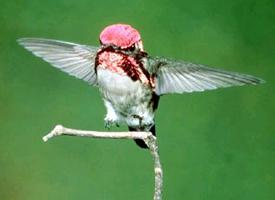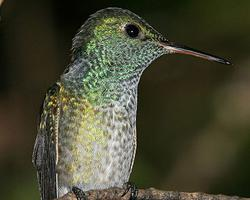
Súlyok és méretek
| Hossz | 21,5 cm |
|---|---|
| Súly | 18-tól 20-ig g |
Veszélyeztetettség
| Veszélyeztetett |
Állatleírás
The Giant Hummingbird (Patagona gigas) is a remarkable avian species, distinguished by its size as the largest member of the hummingbird family. This extraordinary bird inhabits the diverse landscapes of South America, ranging from the arid coastal deserts of Peru and Chile to the high-altitude regions of the Andes Mountains, where it can be found up to elevations of 4,500 meters (14,800 feet).Characterized by its impressive size, the Giant Hummingbird measures approximately 21 to 23 centimeters (8.3 to 9.1 inches) in length and weighs around 18 to 24 grams (0.63 to 0.85 ounces), making it significantly larger than other hummingbird species. Despite its bulk, it retains the characteristic agility and aerial prowess of hummingbirds, capable of hovering in place with rapid wing beats that produce a distinctive, deep humming sound.
The plumage of the Giant Hummingbird varies subtly between the sexes. Generally, it exhibits a predominantly dull green coloration on its upper parts, blending seamlessly with its natural surroundings. The underparts are paler, often grayish or whitish, providing a soft contrast. Males may display a slightly brighter plumage with iridescent patches, especially around the throat area, which can catch the light and shimmer in hues of green and blue. The bird's large, sturdy bill is straight and well-suited for accessing nectar from a variety of flowers, which constitutes the bulk of its diet.
Giant Hummingbirds are solitary and territorial creatures, often seen defending their feeding grounds with great vigor against intruders. They exhibit remarkable adaptability, feeding on the nectar of a wide range of flowering plants, as well as occasionally consuming insects and spiders for protein. Their role as pollinators is crucial, facilitating the reproduction of many plant species across their habitat.
Breeding behavior in Giant Hummingbirds involves elaborate aerial displays by males to attract females. The female alone is responsible for nest construction, which is a compact, cup-shaped structure made of plant fibers and spider webs, strategically placed on a high, slender branch to avoid predators. She lays a clutch of typically two eggs, which are among the largest of any hummingbird species, and assumes all duties related to incubation and feeding of the hatchlings.
Despite their size and adaptability, Giant Hummingbirds face threats from habitat loss and climate change, which could impact their natural food sources and breeding grounds. While currently not listed as endangered, the conservation of their habitat is crucial for their long-term survival.
In summary, the Giant Hummingbird (Patagona gigas) is a fascinating and unique bird that captivates observers with its size, beauty, and aerial prowess. As the largest of the hummingbirds, it plays a vital role in its ecosystem, underlining the importance of preserving its natural habitat for future generations to appreciate and study.
Hasonló állatok
Új állatfotók
Top 10 állat
- Dolphin gull (Leucophaeus scoresbii)
- Japanese macaque (Macaca fuscata)
- Stone loach (Barbatula barbatula)
- Russian tortoise (Testudo horsfieldii)
- Galápagos tortoise (Geochelone nigra complex)
- Greek tortoise (Testudo graeca)
- Diana monkey (Cercopithecus diana)
- Common flying dragon (Draco volans)
- Moustached guenon (Cercopithecus cephus)
- Galápagos penguin (Spheniscus mendiculus)

